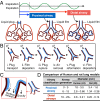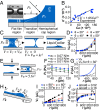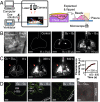Targeted delivery of liquid microvolumes into the lung
- PMID: 26324893
- PMCID: PMC4577144
- DOI: 10.1073/pnas.1512613112
Targeted delivery of liquid microvolumes into the lung
Abstract
The ability to deliver drugs to specific sites in the lung could radically improve therapeutic outcomes of a variety of lung diseases, including cystic fibrosis, severe bronchopneumonia, chronic obstructive pulmonary disease, and lung cancer. Using conventional methods for pulmonary drug administration, precise, localized delivery of exact doses of drugs to target regions remains challenging. Here we describe a more controlled delivery of soluble reagents (e.g., drugs, enzymes, and radionuclides) in microvolume liquid plugs to targeted branches of the pulmonary airway tree: upper airways, small airways (bronchioles), or the most distal alveoli. In this approach, a soluble liquid plug of very small volume (<1 mL) is instilled into the upper airways, and with programmed air ventilation of the lungs, the plug is pushed into a specific desired (more distal) airway to achieve deposition of liquid film onto the lung epithelium. The plug volume and ventilation conditions were determined by mathematical modeling of plug transport in a tubular geometry, and targeted liquid film deposition was demonstrated in rat lungs by three different in vivo imaging modalities. The experimental and modeling data suggest that instillation of microvolumes of liquid into a ventilated pulmonary airway could be an effective strategy to deliver exact doses of drugs to targeted pathologic regions of the lung, especially those inaccessible by bronchoscopy, to increase in situ efficacy of the drug and minimize systemic side effects.
Keywords: alveoli; liquid instillation; lung airway; lung disease; pulmonary drug delivery.
Conflict of interest statement
The authors declare no conflict of interest.
Figures




References
-
- Conway SP, Brownlee KG, Denton M, Peckham DG. Antibiotic treatment of multidrug-resistant organisms in cystic fibrosis. Am J Respir Med. 2003;2(4):321–332. - PubMed
-
- Johnstone RW, Ruefli AA, Lowe SW. Apoptosis: A link between cancer genetics and chemotherapy. Cell. 2002;108(2):153–164. - PubMed
-
- Albert RK, Spiro SG, Jett JR. Clinical Respiratory Medicine. Elsevier; Philadelphia: 2008.
-
- Mason RJ, et al. Murray and Nadel’s Textbook of Respiratory Medicine: 2-Volume Set. Elsevier; Philadelphia: 2010.
-
- Pond SM, Tozer TN. First-pass elimination. Basic concepts and clinical consequences. Clin Pharmacokinet. 1984;9(1):1–25. - PubMed
Publication types
MeSH terms
Substances
Grants and funding
LinkOut - more resources
Full Text Sources
Other Literature Sources
Molecular Biology Databases

